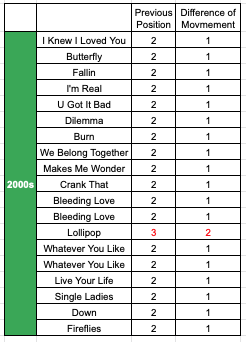Billboard Hot 100 Historical Fluctuations To Return Atop
READING TIME: 5 MINUTES
FOREWORD NOTE: Unfortunately, due to the release of these and related articles, some attached social media accounts, which initially helped to spread the message were found and targeted by the Army and allied parties, eventually leading to the permanent suspension of said accounts for speaking up on a truth.
In the 1980s and before, singles were released with the intention to peak; thereafter either the single was dropped from distribution, or auditing for the top songs meant not taking account of falling singles, despite being in demand, in favour of newer releases. The introduction of Nielsen Soundscan in the 1990s allowed stakeholders to gain a more accurate view of what was popular and being consumed. It could digitally monitor and track physical sales and radio spins and so stakeholders understood that songs actually stuck around on the Hot 100 longer than expected. As time has gone by there have been interruptions where a song may spend a number of non-consecutive number of weeks at the top, and there are many reasons to account for those instances - all relevant in their time period. However, a certain recent single that almost out of the Top 10, to suddenly resurge back atop, inspired this phenomena to be investigated and article to be written.
1990s - 4 singles
With a formula consisting of 50% sales and 50% radio usually a single will dominate for a period of time before descending again, leaving competitive singles little room to budge atop. However, 4 instances across the first decade when Nielsen Soundscan was implemented detected movement of songs which hit the top spot were reduced to single place for a number of weeks before finally ascending once more. There is no common pitfall why they weren’t able to sustain a consecutive reign other than the weeks they descended to the runners-up position was due to a spike in physical releases by their golden-winner competition.
2000s - 17 singles, 19 instances
With physical singles diminishing in distribution in favour of albums, due to the fear of profits dropping in the wake of Napster in the late 90s and early 2000s, the winning ticket to get atop was garnering points 75% through radio and 25% through physical singles sales (slowly moving towards digital sales in 2005). As with the 1990s, the first half of the decade (7/19 instances) saw few unsustained movements from the top spot and many reigns were dictated by increasing radio power. The only spike of seeing many singles descending-and-ascending was during late 2001 with ‘Fallin’, ‘I’m Real’ and ‘U Got It Bad’ regaining atop due to payola radio malpractices within the arms of Sony Music and Arista. In the second half of the decade, while two singles descended twice to number 2 demonstrating their overall strength in audience consumption, only one single descended to third place before ascending back atop: “Lollipop”. It’s competing singles were ‘Bleeding Love’ and ‘Take a Bow’. Similar to the mid-90s where labels would hold on the release of a single until the airplay reached its peak, in order for a single to debut highly, the same strategy was used in the mid-to-late 00s where labels would build up radio allowing a predicted-very popular song to chart in the mid-Hot 100 region, and then release a single immediately after allowing it to shoot right to the top. ‘Take A Bow’ was an early sign of big gainer movement commonly seen in the late-00s to early 10s. Nonetheless Lollipop was solidified by consistent sales and rising airplay allowing it to move up two spots again.
2010s - 27 singles, 31 instances
Kelly’s second topper was impacted in a similar way to Lollipop whereby Katy Perry’s Part of Me, post-Grammy release and the sudden announcement of her divorce, meant the song had been suddenly released on iTunes allowing it to capture much attention and debut atop, along with a reasonable amount of radio airplay to assist. Secondly, as with many celebrity deaths, with the untimely death of Whitney Houston, her signature song ‘I Will Always Love You’ spiked into the top ranks even surpassing ‘Stronger’. These two factors led Kelly’s single to underperform for a week (mostly due to sales) and rested at number 4. Yet as these were one-off rare events, once they were over, the song managed to ascend atop once more.
Billboard in early 2013 revised their rules to allow streaming, including YouTube views, to become a part of the Hot 100 formula with the rise of views, advertisers and YouTube paid subscriptions taking place on the platform. Wrecking Ball already earned a two-week stance helped partly due to its controversial music video, but then sunk under the popular-yet-solemn ‘Royals’ by Lorde. Nonetheless the single remained in the top 2/3 positions (descending once more due to ‘The Monster’ by Eminem and Rihanna) for a further 9 weeks but held strong due to a build-up of radio. In a unique situation at the time, a stroke of luck had come about when a viral parody video containing a snippet of the singer’s single was exposed. It allowed the original music video’s streams to soar, Spotify streams to soar and digital sales increased again - along with the strong airplay it became the longest return back to number one within the same chart run.
‘Nice For What’ was already unprecedented for reaching the top spot in 4 separate instances during the same run. The Summer of 2018 was incredibly competitive even with Drake’s superior reign. You had Post Malone, Ariana Grande and Cardi B, just to name some artists, who were fiercely competing for the top spot. Nonetheless ‘Nice For What’ began to naturally descend after almost 3 months once its streams, airplay and sales began to weaken. However, on the arrival of the parent album (Scorpion) being released, the strategy of Nice For What being available as both an individual single, and as part of the parent project, allowed it to be streamed twice which propelled it, along with a decent amount of airplay still in circulation, to number one once more.
2020s - so far in nearly 2 years: 8 singles, 10 instances
Movements are more shaky in the 2020s due to the random spikes (debuts) that can occur in digital sales and streaming. As a result, when it comes to the Christmas period naturally classic Christmas songs are in high rotation on radio and in high demand on streaming platforms. This is what’s known as the ‘Christmas freeze’ where artists/labels are reluctant to put out new material around December/January due to the influx of Christmas material that will get consumed instead. Nevertheless, some songs managed to stick it out and still succeed thereafter. Notable cases are ‘Circles’ by Post Malone and ‘Mood’ by 24Goldn and Iann Dior. Both songs had the highest airplay out of their peers pre-Christmas period, which allowed it to stabilise within the Top 10 before shooting back atop once the Christmas freeze period has ended. Mood performed exceptionally in the fact that it was at number 7 and surrounded by 6 Christmas-related songs above and below it, while every other song was shoved out. Whilst the songs have some of the lowest positions to again regain the top spot, it is extremely understandable why. Also Mood’s drop to number 3 and then rise to number 1 a week later was attributed to exceeding streams and sales of superstar Ariana Grande’s new song ‘Positions’ and country star Luke Comb’s ‘Forever After All’ debuting a rare No. 1 and No. 2 feat.
*1-1-1-1-1-1-1-7-1…there is no legitimate excuse like all the above songs had, why this song dropped 6 positions within a single week and then it suddenly surged back right to the top the following week. This is the most volatile movement in Nielsen Soundscan history. Most of its peers within the Top 10 have been able to remain stable across all metrics. However, with this song’s abysmal radio performance and lacklustre streaming numbers, given where it’s placed, its diminished digital sales were intentionally sabotaged in favour for the new group’s single. Meaning the mass-purchasing tactic had to switch and focus on the new release, and a smaller ratio of funds would still be preserved for it to remain in the Top 10. Again more remixes and congregations over social media meant the new single than dropped immediately to Number 7 and traded places for the top spot the following week once realising the newer song wasn’t meet sales expectations. There’s no sudden deaths, no new competition to debut, no Christmas freeze, no parodies since it’s not widely-recognised and no parent project to double-up.
Final Thoughts
Currently 2021 has not finished and already 8 singles have moved from the top spot before regaining it again. This pattern of fluctuation is bound to happen much more with time, as the number of instances this phenomena takes place per decade seems to keep increasing rapidly. With the exception of the Christmas freeze survivor songs, and taking the last “song” into deep consideration, it’s no more a hidden truth that the formula is unstable / not truly showing what is THE most overall popular song if you can drop dramatically one week and rise dramatically the next.










